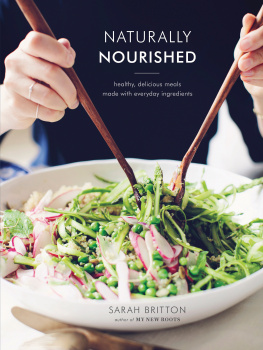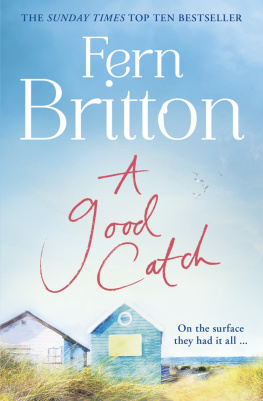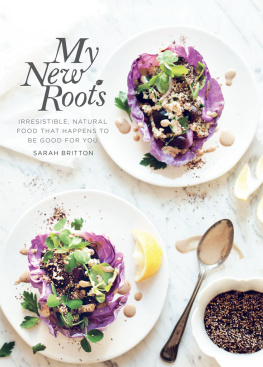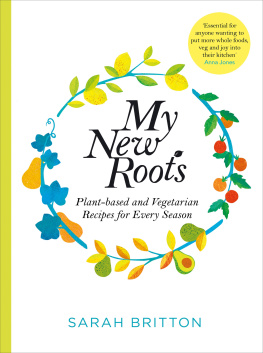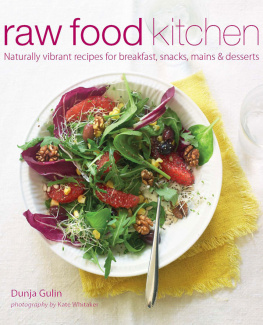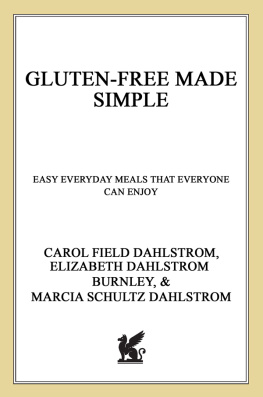ABOUT THE AUTHOR
Sarah Britton, BFA, CNP, is the acclaimed holistic nutritionist, writer, and photographer behind the cookbook My New Roots and the popular healthy foods blog of the same name, which won a 2014 Saveur Best Food Blog award. She has been featured in O, The Oprah Magazine, Bon Apptit, Saveur, and Whole Living and has spoken at TedTalks and many nutrition seminars and workshops throughout North America and Europe. She lives in Copenhagen with her husband and their son.
BUYING AND STORING KITCHEN STAPLES
The following ingredients are what I would consider kitchen staples, and for that reason its important to invest in good-quality versions of them. If you cant get some of these things at your local store, I think they are worth a trip to the health food store (or order them online), since you will be using them very frequently.
Cold-Pressed Olive Oil
Buying: When purchasing olive oil, look for a product in a dark glass bottle. Light destroys the delicate nutrients in the oil, so its essential that the colored glass is green, brown, or blue, not clear. Never purchase olive oil in a plastic container. Its okay to purchase oil sold in a tin, but be sure to transfer it to a dark glass bottle when you get home. Look for the terms unrefined and cold-pressed on the label, meaning that it was extracted on the first pressing, processed at lower temperatures without chemicals, and still contains the most nutrition and flavor.
Storing: Olive oil will keep for 2 to 3 months after opening, so buy only the amount you need and use it up before then. Store it away from heat: in the refrigerator or in a very small bottle in a relatively cool, dark place.
Coconut Oil
Burned and oxidized fats cause free-radical damage in the body (that means no more cooking with olive oil!), so its important to cook with oils that have a high smoke point. Coconut oil is a great choice.
Buying: To avoid coconuts overwhelming flavor, choose expeller-pressed, steam-refined, non-hydrogenated coconut oil, which has a neutral taste. Cold-pressed virgin coconut oil has a strong flavor and is best with raw foods.
Storing: Because it is so stable, coconut oil can be stored at room temperature for up to 1 year. If coconut oil comes packaged in plastic, transfer it to a glass jar.
Soy Sauce and Tamari
Soy sauce comes in two varieties: light and dark. The light one is lighter in color with a low viscosity and is extremely salty. This type is more expensive than the dark and is used as a condiment at the table. Dark soy sauce is deep in color with a higher viscosity and a sweeter flavor (usually due to additives such as caramel color or molasses). Dark soy sauce is used more frequently in cooking. Tamari is my top pick for soy-based sauces, because it is gluten-free (check the labelit must say gluten- and wheat-free). Tamari is traditionally brewed, has a stronger flavor than soy sauce, and is best used to season longer-cooking foods, such as soups, stews, and baked dishes.
Buying: I highly recommend purchasing good-quality soy products whenever possible. Look for the terms traditionally brewed, organic, and non-GMO. The conventional and less expensive versions of this seasoning may contain food dyes, refined sweeteners, preservatives, and chemical residues from processing.
Storing: Opened soy condiments will keep in the fridge for 2 to 3 months.
Fine and Flaky Salt
There are two types of salt I use on a daily basis: fine and flaky sea salt. Fine sea salt is good for seasoning during cooking and, of course, baking, because it is easy to measure and dissolves evenly. Flaky sea salt, sometimes called finishing salt, has a coarse texture that makes it easy to pinch between your fingers and sprinkle onto cooked foods as a garnish or to adjust the seasoning. Avoid table saltit is highly refined with many additives and has an unpleasant, bitter aftertaste that can spoil the delicate flavors of food (plus, after processing, table salt can be just as harmful as processed white sugaralthough it is generally eaten in much smaller quantities).
Buying: When purchasing salt, look for all-natural, dried (not boiled), unrefined salts with no added ingredients. Sea salt and Himalayan crystal salt are the types I use most often.
Storing: Store salt in glass, ceramic, stone, or wood containers (do not store it in metal, or it will corrode the container), or keep small amounts in a salt cellar on your counter for easy access. Salt will keep indefinitely if stored in a dry, clean environment.
Black Pepper
Black pepper does not have to be expensive, but I do insist that it is ground fresh in a pepper mill.
Buying: Always purchase whole black peppercorns. For my recipes, I like a medium-coarse grind from a pepper mill. Invest in a good mill, grind your own, and your life will be forever changed.
Storing: Store whole black peppercorns as you would all spices, in an airtight container away from heat and light. Peppercorns will keep for 1 to 2 years.
Lemon
When a recipe in this book calls for lemon juice, I am referring to freshly squeezed lemon juice from the real citrus fruit, not the liquid in a yellow plastic lemon (which contains preservatives and sulfites).
Buying: I call for lemon zest quite often in this bookit has a ton of flavor! For this reason, try to buy organic lemons if you can find them. But if you can only find conventional lemons, wash them really well.
Storing: Lemons kept in an airtight bag in the refrigerator will stay juicy and fresh for up to 1 month.
Apple Cider Vinegar
Apple cider vinegar adds delicious zing to all kinds of foods and is perfect for pickling. It is rich in enzymes, aids digestion, alkalinizes the body, and supports a healthy immune systemtruly a miracle food!
Buying: Made from fermented apple cider, apple cider vinegar should always be purchased unpasteurized (raw), unfiltered with the mother (the cobweb-like strands of good bacteria in the vinegar), and organic, if possible. Look for it in glass bottles.
Storing: Apple cider vinegar is highly acidic, so it can last for many months outside of the refrigerator without spoiling, but keeping it in a cool, dry place away from direct sunlight, such as in a pantry cupboard, is still important. If you know that you wont be using it very often, I suggest keeping it in the fridge.
Pure Maple Syrup
Maple syrup is by far my favorite sweetener, conveniently gluten-free, vegan, and easy to find. Its true that it may be more expensive than other sweeteners, but I believe it is worth the investment for both taste and nutrition.
Buying: When purchasing maple syrup, its essential to read the ingredients listit should have only 100 percent pure maple syrup listed. Avoid buying a product that contains maple flavor, high-fructose corn syrup, or other sweeteners, or that is labeled with the terms pancake syrup or breakfast syrup. If your grocery store offers different grades of maple syrup, choose Grade B over Grade A. Grade B maple syrup is from sap that is collected later in the season, is deeper in color, far more flavorful, and contains higher amounts of minerals.
Storing: Open bottles of pure maple syrup should be stored in the refrigerator and will keep for up to 1 year.
Herbs
Fresh herbs are not just a garnish in my recipes; they are a critical element that can take a weeknight meal to great heights and help transform a humble pot of brown rice into something special. Most peoples main complaint about herbs is that they buy a bunch for a teaspoon or so to use in one recipe and the rest of it rots in the fridge! I hope the recipes and Rollover ideas in this book give you plenty of ideas and reasons to use every last scrap of your fresh herbs.
Next page
